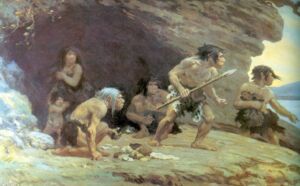Business & Education
One man’s long journey to the centre of the earth’s creation
This article is more than 9 years old.
While Saxo Grammaticus gave us a history of Denmark, Johannes Vilhelm Jensen went one better: he rewrote the Bible!

These guys enter the equation in Chapter 2 (photo: Charles Robert Knight, 1874–1953)
In 1908, the well-established Danish writer Johannes Vilhelm Jensen, the father of Danish modernism, had the audacity to imagine the impossible. It took him the next 14 years to complete his magnum opus – an alternative to the Bible.
A mythical epic
‘Den lange rejse’, published in English as ‘The Long Journey’ in 1924, is a mythical epic with deep spiritual purposes. Jensen’s idea was to provide a realistic account of human existence, based on Darwin’s ‘Theory of Natural Selection’. He used the Darwinist ideas as a model for his description of human development from the Ice Age until Christopher Columbus. Ultimately he wanted to emphasise that the reality of human existence is itself still an absolute wonder.
‘The Long Journey’ consists of six separate books. The work was not originally planned as a narrative of human existence and development from before the Ice Age until modern times. It was developed in pieces, after Jensen wrote ‘Bræen’ (‘The Glacier’) in 1908 and ‘Skibet’ (‘The Ship’) in 1912, he began to realise the scope of the work he had started.
Spurred on by the Great War
The outbreak of the First World War intensified his progress on the books, as he felt the need to privately counter the destruction of war and mass killings with a new version of the creation story. His working notes for the six volumes explain his motivation, and they were published in a literary testament called ‘Aesthetics and Development’ (1923), which was reprinted at the end of the collected works.
In this postscript he places his work in the literary tradition of favourite poets such as Johann Wolfgang von Goethe, Knut Hamsun, HC Andersen and Adam Oehlenschläger.
No Prometheus, just primitive man
The books (see factfile) make for grim reading in places, because evolution is a tough business. The first two books take place somewhere in the primeval forests of Europe near a volcano with a summit of fire and trails of lava.
Primitive man worships the fire until a man with a mind and a will captures it from the volcano with a torch. With it he lights campfires to keep away wild beasts. In the end the other primitives cause his death, but he has already brought order from chaos. He determines the concept of time from the movement of the stars and love as a civilized intercourse between individuals.
It’s getting cold … enter the Nordics
Time lapses between each book. In the next two books, the climate is cooling and there is a general migration to the south. One man sets off in the opposite direction to the icy lands of the north to wrestle with hardship. Defying the cold, he grows hardy and strong. With a woman he meets in the north, he becomes the father of the Nordic race and makes fire by striking it out of two minerals. And thus he founds a new civilization.
And the final two books cover the invention of locomotion: wagons and boats driven by oar or sail. The later books describe the Cimbrians marching on Rome and the Vikings’ raids. At the end Columbus finds a new dream of a tropical paradise.
A spiritual process
Interpreting nature and history is for Jensen a spiritual process. For Jensen, a medical student who grew up in the countryside and became a writer in Denmark’s largest city, biology is life’s poetry. In the spiritual undertones of the book, Jensen does not make a clear choice about creation. It is driven by both spirit and matter, not one or the other.
Jensen works in the interplay between mind and matter to show the process as a struggle in holistic interpretation, that spirit and matter both condition and enrich each other. He wants to keep the notion of life as a miracle without losing the logic and science of evolutionary theory.
Nobel prize winner
Jensen was both a shy and self-conscious writer; however, in his opinions he was often strict and challenging. He created a new kind of environment-orientated, evocative prose and poetry in Denmark in the first half of the 20th century. In 1944 he was awarded the Nobel Prize for Literature “for the rare strength and fertility of his poetic imagination with which is combined an intellectual curiosity of wide scope and a bold, freshly creative style”, the Nobel Committee noted.
“‘The Long Journey’ is like a series of huge decorative paintings in which characterisation is less important than the range of composition and the incomparable skill of the brush strokes,” its chairman Per Hallström added.
And out of all of his works, this series on primitive man’s development has lingered the longest in the imagination. Not least as an inspiration for the Danish artists Asger Jorn and Pierre Wemaëre, whose huge, 14-metre long, collaborative tapestry work was also entitled ‘The Long Journey’ (1958).










































